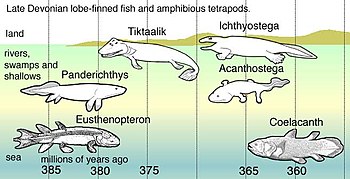Ichthyostega
| Ichthyostega Temporal range: Devonian
| |
|---|---|

| |
| Scientific classification | |
| Kingdom: | |
| Phylum: | |
| Superclass: | |
| Order: | Ichthyostegalia
|
| Family: | Ichthyostegidae
|
| Genus: | Ichthyostega Säve-Söderbergh, 1932
|
| Species | |
|
I. stensioei | |
Ichthyostega (Greek: "fish roof") is an early tetrapod genus living in the Upper Devonian (Famennian) period, 367-362.5 million years ago, and the first to intermediate between fish and amphibians. Ichthyostega had legs but its limbs probably weren't used for walking as once believed, but were used instead to negotiate its way through the swamps of the time. It is sometimes refered to as an "amphibian" but is not a true member. The first true amphibians appeared in the Carboniferous.
History and systematics
Säve-Söderbergh, 1932a described four Ichthyostega species from the Upper Devonian of East Greenland and one species belonging to the genus Ichthyostegopsis, I. wimani. These species could be synonymous (in which case only I. stensioei would remain), because their morphological differences are not very pronounced. The species differ in skull proportions, skull punctuation and skull bone patterns. The comparisons were done on 14 specimens collected in 1931 by the Danish East Greenland Expedition. Additional specimens were collected between 1933 and 1955.
The genus is closely related to Acanthostega gunnari, also from East Greenland. Ichthyostega's skull seems more fish-like than that of Acanthostega, but its girdle (shoulder and hip) morphology seems stronger and better adapted to land-life. Ichthyostega also had more supportive ribs and stronger vertebrae with more developed zygapophyses. The first tetrapods (who probably didn't walk on land) were Elginerpeton and Obruchevichthys.
Characteristics
Ichthyostega was about 1.5 meter long and had seven digits on each hind foot. The exact number of digits on the hand is not yet known, but was probably about the same as on the foot. It had a fin containing fin rays on its tail.
Adaptations for land-life
Primitive tetrapods like Ichthyostega and Acanthostega differed from animals like Crossopterygians (for instance Eusthenopteron or Panderichthys) in that although Crossopterygians had lungs, they used their gills as the primary means of acquiring oxygen. Ichthyostega probably used lungs as its primary means of breathing. Primitive tetrapods had a special type of skin that helped them retain bodily fluids and deter desiccation, whereas Crossopterygians did not. Moreover, Crossopterygians used their body and tail to move about and their fins for balance while, Ichthyostega instead used its limbs for locomotion and its tail for balance.

The adult animals were so big and heavy (1.5 m or 4 ft) and poorly adapted for terrestrial locomotion that there probably wouldn't have been much benefit to their being on land. However, the massive ribcage is made up of overlapping ribs -- and compared to their ancestors, the body has a stronger skeletal structure, a more advanced spine, and forelimbs with possibly enough power to pull the body from the water. These anatomical modifications are clearly evolved to handle the gravity experienced on land. The hindlimbs were smaller and so weak they couldn't have been able to bear the weight of an adult. Jennifer A. Clack suggests that Ichthyostega and relatives were spending time basking in the sun to raise their temperature, perhaps adopting a similar lifestyle to that of the marine iguana on Galapagos, seals or the Gharial -- mostly returning to water for food, to drink, to reproduce, or to cool down. In that case, they would need strong forelimbs to pull at least their anterior part out of the water, and a stronger ribcage and spine to support them while sunbathing on their abdomen like modern crocodiles. The juveniles, on the other hand, would have been able to move around on land much more easily.
Water was also still a requirement, because the jelly-like eggs of the earliest terrestrial tetrapods couldn't survive out of water, so reproduction could not occur without it. Water was also needed for their larvae and external fertilization. Most land-dwelling vertebrates have since developed two methods of internal fertilization; either direct as seen in all amniotes and a few amphibians, or indirect for many salamanders by placing a spermatophore on the ground which then is picked up by the female salamander.
Ichthyostegoids (Elginerpeton, Acanthostega, Ichthyostega, etc.) were "succeeded" by temnospondyls and anthracosaurs, such as Eryops, an amphibian that truly developed the ability to walk on land. There is a gap of 20-30 million years between both groups. This gap, a classic in vertebrate paleontology, is known as Romer's Gap, after the American paleontologist Alfred Sherwood Romer. In 2002 a 350 million year old fossil named Pederpes finneyae was found.
See also
External links
- Excellent site on early tetrapods
- Course site
- Course site
- First Four-Legged Animals Inched Along
- Getting a Leg Up on Land Scientific American Nov. 21, 2005, article by Jennifer A. Clack.
References
- Blom, H. (2005) — Taxonomic Revision Of The Late Devonian Tetrapod Ichthyostega from East Greenland. Palaeontology, 48, Part 1:111–134
- Westenberg, K. (1999) — From Fins to Feet. National Geographic, 195, 5:114–127
